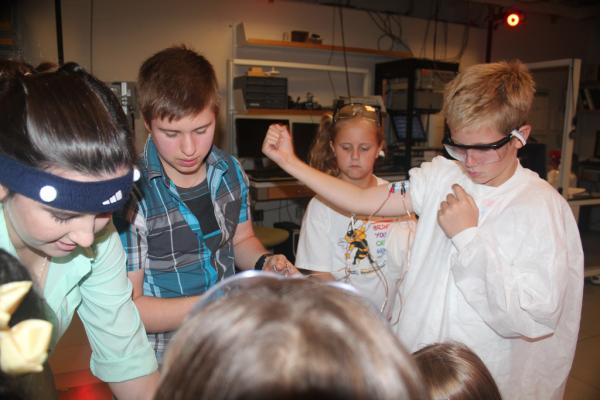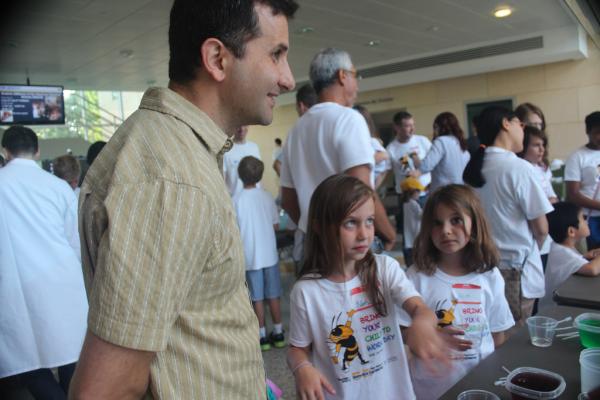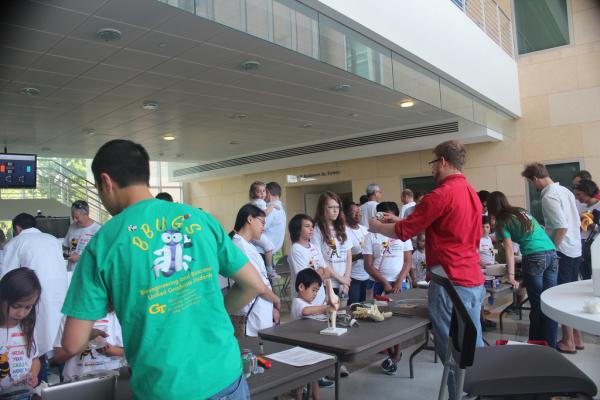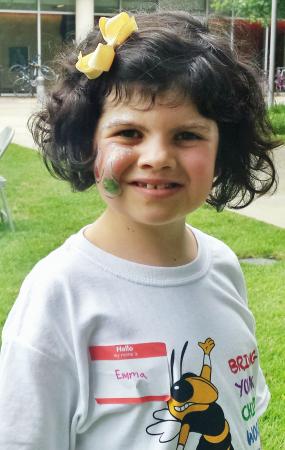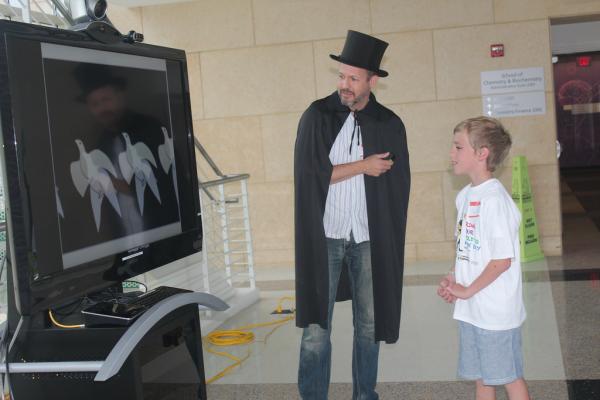First ‘Bring Your Child/Grandchild to Work Day’ a Hit with BME Community.
Brains and hearts and eyes – these are among the gooey, essential elements that helped make the first ‘Bring Your Child to Work Day’ (Friday, June 13) at the Wallace H. Coulter Department of Biomedical Engineering (BME) a success. Well, that and face painting. And silly putty.
Faculty and staff brought their kids (25 in total, ages 2 to 14) for a day of fun and learning, and department chair Ravi Bellamkonda hopes the community building event will become an annual tradition.
“We are interested in building the best possible BME department in the world, and this is only possible when our faculty, staff and students view the department as part of their family,” says Bellamkonda. “This event is one of many we envision to invite not just our faculty, staff and students to share what they do with their children, but also to celebrate all of them as a whole, not just the ‘work’ part of them.”
The lines between work, family and recreation converged, or were blurred, for all the participants last Friday. In some cases, it was mainly about the recreation. Shannon and Tom Barker (director of graduate training, and associate professor/Petit Faculty Fellow, respectively, in the Coulter Department) brought their kids, who had a blast, according to Shannon.
“It was wonderful to interact with faculty and staff outside of our normal work routines,” she says. “My daughter is still talking about it, which is pretty high praise given the attention span of a four year old. Given my kids young age, their favorite part was after lunch: the bouncy house and the balloon man, as my daughter calls him, who made her a treasured pink pony.”
Basically, this was the ultimate show-and-tell experience, with lab tours, demonstrations, experiments and games for the kids, and it definitely left an impression. “I liked the face painting and touching the pig’s eyeball. Science is awesome,” says six-year-old Emma Sullivan, whose mom, Shannon Sullivan, graduate program coordinator for the Coulter Department, adds, “It was a great opportunity to expose her to science in a unique way, but mostly it was just plain fun for both of us.”
That’s exactly the kind of reaction Bellamkonda was going for.
“We do some amazing things in the department in terms of our research and we are always happy to open our doors to children, to interest them in science and engineering,” says Bellamkonda, who saw only happy faces (many of them painted), and people delighted with activities that also included, “touching brains and dissecting eyes and touching hearts and learning about optics and materials.”
A range of demonstrations was designed for kids to learn scientific principles used in bio-complex labs, with an emphasis on hands-on fun, according to Ph.D. student Kyle Blum, an NIH Computational Neuroscience Trainee, who participated in the demos as well as the tour of Professor Lena Ting’s lab.
“My two favorite demos were the cardiovascular demo, in which we had dissections of pig and chicken hearts prepared for the kids to learn about how blood is pumped through our bodies, and the edible cell demo, in which kids made their own large-scale cells out of candy that resembled different cellular organelles, and learned about what each of them does along the way,” Blum says.
“For the Ting Lab tour, we had demonstrations set up for the kids with their parents and grandparents to teach them how we study sensorimotor control of posture and balance,” he adds. “We were able to demonstrate how we elicit reactive postural responses experimentally by having volunteers stand on our motorized platform and moving it to throw them off balance. In addition to the platform, we showed them how we can record their motions and use electromyography to measure the neural response to the movement of the platform. It was great to see both the kids and their parents asking questions about what our lab does, and hopefully learning about neuroscience from the experience.”
Bounce houses in the bio-complex, a hands-on experiments table, the lab tours filled with kids wearing lab coats, balloons and ice cream – all in all, not your typical day at the office. Donna Sibble, business administrator in the Coulter Department, brought her grandson Julian, who enjoyed the magic show (Professor Garrett Stanley, complete with cape) and the experiments, but was especially thrilled to visit Ross Ethier’s lab, where they were dissecting a pig’s eyeball.
“On our way home,” Donna says, “he pleaded with me to stop by the store to buy Borax and Elmer’s Glue so that he could replicate the ‘silly putty’ he made at the experiment table. I truly look forward to bringing him again next year.”
Media Contact
Jerry Grillo
Communications Officer II
Parker H. Petit Institute for
Bioengineering & Bioscience
Keywords
Latest BME News
Jo honored for his impact on science and mentorship
The department rises to the top in biomedical engineering programs for undergraduate education.
Commercialization program in Coulter BME announces project teams who will receive support to get their research to market.
Courses in the Wallace H. Coulter Department of Biomedical Engineering are being reformatted to incorporate AI and machine learning so students are prepared for a data-driven biotech sector.
Influenced by her mother's journey in engineering, Sriya Surapaneni hopes to inspire other young women in the field.
Coulter BME Professor Earns Tenure, Eyes Future of Innovation in Health and Medicine
The grant will fund the development of cutting-edge technology that could detect colorectal cancer through a simple breath test
The surgical support device landed Coulter BME its 4th consecutive win for the College of Engineering competition.

